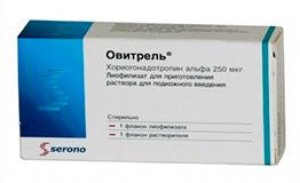
All iLive content is medically reviewed or fact checked to ensure as much factual accuracy as possible.
We have strict sourcing guidelines and only link to reputable media sites, academic research institutions and, whenever possible, medically peer reviewed studies. Note that the numbers in parentheses ([1], [2], etc.) are clickable links to these studies.
If you feel that any of our content is inaccurate, out-of-date, or otherwise questionable, please select it and press Ctrl + Enter.
Ovitrel
Medical expert of the article
Last reviewed: 03.07.2025

ATC classification
Active ingredients
Pharmacological group
Pharmachologic effect
Indications Ovitrel
Ovitrelle is intended for the treatment of infertility in women due to ovarian hypofunction or problems with natural ovulation. The drug is used for in vitro fertilization and is also used to prepare the body for in vitro fertilization (IVF) - for the purpose of final maturation of follicles after follicle-stimulating therapy.
Pharmacodynamics
The gonadotropic effect of Ovitrelle - initiation of ovulation - is provided by the recombinant hormone chorionic gonadotropin α, which is an analogue of endogenous human chorionic gonadotropin (hCG), synthesized by the placenta during pregnancy and possessing high luteinizing activity.
By binding to luteinizing hormone (LH) receptors on the cytoplasmic membranes of glycoproteins surrounding ovarian follicles and the basal membranes of theca cells, alpha-choriogonadotropin induces the onset of reduction division of the egg and ovulation (release of the egg from the follicle). In addition, the granulosa cells of the follicle begin to form the corpus luteum of the ovary, which produces large amounts of progesterone.
Pharmacokinetics
After the drug is administered subcutaneously, alpha-choriogonadotropin is absorbed into the extracellular fluid and enters the bloodstream, bioavailability does not exceed 40%. The half-life of Ovitel is about 30 hours.
 [ 10 ]
[ 10 ]
Dosing and administration
Ovitrelle is used only in specialized medical institutions by appropriately qualified physicians.
Ovitrelle is administered by subcutaneous injection (0.25 mg) according to a specific regimen that corresponds to the intended purpose. The use of this drug involves the preliminary administration of hormonal drugs based on menopausal gonadotropin or follicle-stimulating hormone.
Use Ovitrel during pregnancy
Ovitrelle is not used during pregnancy.
Contraindications
Ovitrelle is contraindicated for use in the following cases:
- tumor formations of the pituitary gland or hypothalamus;
- hypertrophy and cystic disease of the ovaries;
- fibrous hyperplasia in the uterus;
- malignant epithelial tumors (carcinomas) of the ovaries, uterus or mammary glands;
- uterine bleeding;
- vascular pathologies (thrombosis, embolism).
Side effects Ovitrel
The use of Ovitrelle may be accompanied by side effects such as headache, nausea, vomiting, diarrhea or constipation, decreased blood pressure, mastalgia (pain in the mammary glands), decreased urine production (oliguria), pain and a feeling of heaviness in the abdominal cavity, thromboembolism, skin rashes, Quincke's edema, sleep and mood disorders.
 [ 13 ]
[ 13 ]
Overdose
Ovitrelle may cause ovarian hyperstimulation - an increase in the size of the ovaries with the risk of torsion and rupture.
 [ 16 ]
[ 16 ]
Interactions with other drugs
Ovitrelle does not interfere with other medications. According to the manufacturer, a pregnancy test may be falsely positive for a week after using this drug.
 [ 17 ]
[ 17 ]
Storage conditions
In sealed packages, the drug should be stored at +15-25°C; an unopened bottle of powder – at a temperature of +2-8°C for a maximum of 30 days; the drug in an unpacked syringe cannot be stored.
Shelf life
Shelf life: 24 months.
Manufacturer
Attention!
To simplify the perception of information, this instruction for use of the drug "Ovitrel" translated and presented in a special form on the basis of the official instructions for medical use of the drug. Before use read the annotation that came directly to medicines.
Description provided for informational purposes and is not a guide to self-healing. The need for this drug, the purpose of the treatment regimen, methods and dose of the drug is determined solely by the attending physician. Self-medication is dangerous for your health.

